Flathead engine
.jpg)
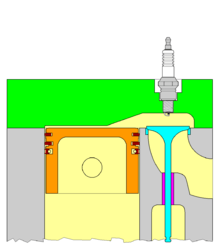
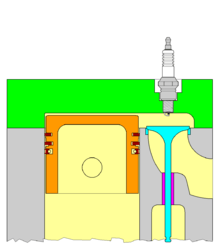
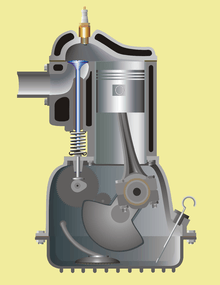
A flathead engine, otherwise sidevalve engine,[1][2] is an internal combustion engine with its poppet valves contained within the engine block, instead of in the cylinder head, as in an overhead valve engine.
Flatheads are an early design concept that has mostly fallen into disuse, but they are currently experiencing a revival in low-revving aero-engines such as the D-Motor.[3]
The side-valve design
The valve gear comprises a camshaft sited low in the cylinder block which operates the poppet valves via tappets and short pushrods (or sometimes with no pushrods at all). The flathead system obviates the need for further valvetrain components such as lengthy pushrods, rocker arms, overhead valves or overhead camshafts).[4] The sidevalves are typically adjacent, sited on one side of the cylinder(s); but some flatheads employ the less common "crossflow" "T-head" variant. In a T-head engine, the exhaust gases leave on the opposite side of the cylinder from the intake valve.
The sidevalve engine's combustion chamber is not above the piston (as in an ohv engine) but to the side, above the valves. The spark plug may be sited over the piston (as in an ohv engine) or above the valves; but aircraft designs with two plugs per cylinder may use either or both positions.[5]
"Pop-up pistons" may be used with compatible heads to increase compression ratio and improve the combustion chamber's shape to prevent knocking.[6] "Pop-up" pistons are so called because, at tdc, they protrude above the top of the cylinder block.
Advantages
The advantages of a sidevalve engine include: simplicity, reliability, low part count, low cost, low weight, compactness, responsive low-speed power, low mechanical engine noise, and insensitivity to low-octane fuel. The absence of a complicated valvetrain allows a compact engine that is cheap to manufacture, since the cylinder head may be little more than a simple metal casting. These advantages explain why side valve engines were used for economy cars, trucks, and agricultural engines for many years, while OHV designs came to be specified only for high-performance applications such as aircraft, luxury cars, sports cars, and some motorcycles.
At top dead centre, the piston gets very close to the flat portion of the cylinder head above, and the resultant squish turbulence produces excellent fuel/air mixing. A feature of the sidevalve design (particularly beneficial for an aero-engine) is that if a valve should seize in its guide and remain partially open, the piston would not be damaged, and the engine would continue operating safely on its other cylinders.
Disadvantages
The main disadvantages of a sidevalve engine are poor gas flow, poor combustion chamber shape, and low compression ratio, all of which result in a low-revving engine with low power output.[7]
In a sidevalve engine, intake and exhaust gases follow a circuitous route, with low volumetric efficiency, or "poor breathing", not least because the exhaust gases interfere with the incoming charge. Because the exhaust follows a lengthy path to leave the engine, there is a tendency for the engine to overheat. Although a sidevalve engine can safely operate at high speed, its volumetric efficiency swiftly deteriorates, so that high power outputs are not feasible at speed. High volumetric efficiency was less important for early cars because their engines rarely sustained extended high speeds, but designers seeking higher power outputs had to abandon the sidevalve. A compromise used by the Willys Jeep, Rover, Landrover, and Rolls-Royce in the 1950s was the "F-head" (or "intake-over-exhaust" valving), which has one sidevalve and one overhead valve per cylinder.[8]
The flathead's elongated combustion chamber is prone to preignition (or "knocking") if compression ratio is increased, but improvements such as laser ignition or microwave enhanced ignition might help prevent knocking.[9] Turbulence grooves may increase swirl inside the combustion chamber, thus increasing torque, especially at low rpm. Better mixing of the fuel/air charge improves combustion and helps to prevent knocking.[10][11][12][13]
An advance in flathead technology resulted from experimentation in the 1920s by Sir Harry Ricardo, who improved their efficiency after studying the gas-flow characteristics of sidevalve engines.[14]
The difficulty in designing a high-compression-ratio flathead means that most tend to be spark-ignition designs; and flathead diesels are virtually unknown.
History and applications
The sidevalve arrangement was once the most common across all motor industries (automotive, agricultural, marine, aviation, and others), but has since about 1930 it fallen from favor in most multicylinder applications, such as automotive and aviation, having been displaced by overhead valve designs. Sidevalve designs are still common for many small single-cylinder or twin-cylinder engines, such as lawnmowers, rotavators, two-wheel tractors and other basic farm machinery. American LaFrance powered their fire engines with T-head engines from the 1920s to the 1950s; and early Stutz engines were T heads.
Flathead cars
Multicylinder flathead engines were used for cars such as the Ford Model T, the Ford flathead V8 engine and the Ford Sidevalve engine. Cadillac produced V-16 flathead engines for their Series 90 luxury cars from 1938–1940.[15] After WWII, flathead designs began to be superseded by ohv designs. Flatheads were no longer common in cars, but they continued in more rudimentary vehicles such as off-road military Jeeps. In US custom and hot rod circles, restored examples of early Ford flathead V8s are still seen.[1][16]
Flathead aero-engines
The simplicity, lightness, compactness and reliability might seem ideal for an aero-engine, but because of their low efficiency, early flathead engines were deemed unsuitable, a notable exception being the American Aeronca E-107 opposed twin aero engine of 1930.
Two modern flatheads are the Belgian D-Motor flat-fours and flat-sixes.[17] These are extremely oversquare and compact aero-engines with direct drive to a propeller.[18] As these engines were designed to produce peak power at only 2800 rpm, their very low engine speed meant the designers could dispense with the complexity and weight of an ohv valvetrain. [19][20][21]
Flathead motorcycles
Flathead designs have been used on a number of early pre-war motorcycles, in particular US V-twins such as Harley-Davidson and Indian, some British singles, BMW flat twins and Russian copies thereof.[22] The Cleveland Motorcycle Manufacturing Company produced a T-head four-cylinder in-line motorcycle engine in the 1920s.
- 1915 Cadillac flathead engine block
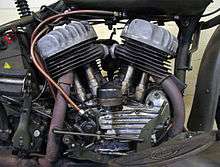 Harley-Davidson flathead
Harley-Davidson flathead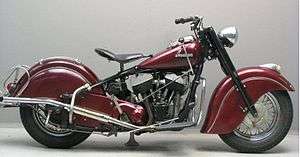 Indian Chief Black Hawk
Indian Chief Black Hawk.jpg) BMW R12
BMW R12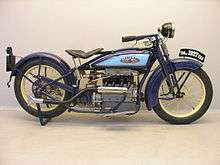 Cleveland Model 4-45
Cleveland Model 4-45
See also
Notes
- 1 2 American Rodder, 6/94, pp.45 & 93.
- ↑ (As the cylinder cross-section has the shape of an inverted L, other names such as "L-block" or "L-head" are also used).
- ↑ D-Motor image
- ↑ An exception is the Indian which employs both rocker arms and pushrods to transmit motion from the cam lobes to the valve stems.
- ↑ The D-motor flathead aero-engines have both spark pugs above the valves.
- ↑ Davis, Marlan (September 29, 2006). "Ford Flathead V8 – The Flathead Guide of Death". Hotrod.com. Hot Rod Magazine. Combustion Chamber. Retrieved 2014-04-08.
Trying to gain back compression ratio by using popup pistons may improve airflow provided proper attention is paid to the transfer area and overall piston-to-combustion chamber interface. The best balance has been the subject of debate for over 60 years. Currently the most popular approach is running a big popup piston, but with a scallop on the side adjacent to the valves to keep the transfer area clear between the valves and the cylinder bore. Recommended bottom-line street-gas-friendly compression ratios are between 7.5–8:1 on naturally aspirated engines and 6.5–7.0:1 with a blower.
- ↑ "A critique of the flathead or side valve engine". Retrieved 2015-08-22.
- ↑ Road and Track, some time in the 1960s
- ↑ Ikeda, Yuji; Nishiyama, Atsushi; Kaneko, Masashi (January 5–8, 2009). Microwave Enhanced Ignition Process for Fuel Mixture at Elevated Pressure of 1MPa (PDF). 47th AIAA Aerospace Sciences Meeting Including The New Horizons Forum and Aerospace Exposition. American Institute of Aeronautics and Astronautics. p. 1. Archived from the original (PDF) on 2014-07-25. Retrieved 2014-07-03.
With plasma-enhanced combustion, a large flame kernel formed and the flame propagation speed increased. In the single-cylinder engine, the combustion stability improved and the microwave-enhanced ignition increased the lean limit from 19.3 to 24.1.
- ↑ Graeber, Charles (September 23, 2004). "Obsession: Mr. Singh's Search for the Holy Grail". Popular Science. Bonnier. Retrieved 2014-07-03.
In November 2002 Singh actually received one such permission from a manufacturer to test his modification on its engines. The manufacturer was Briggs and Stratton, and the engines were two 149cc side valves.
- ↑ Pirangute, V. G.; N.V.Marathe (January 14, 2002). Full throttle performance (PDF) (Technical report). ARAI. PUS/2407/Garuda/52(d). Archived from the original (PDF) on 2016-10-07. The test report reveals that fuel consumption and temperatures decreased at low engine speed while torque increased.
- ↑ amrelweekil (September 14, 2009). "Engine modify by Somender Singh". YouTube. Grooved flathead at 1:31–1:38. Retrieved 2014-04-09.
- ↑ Patent US 6237579 Somender Singh: "Design to improve turbulence in combustion chambers"
- ↑ The internal-combustion engine by Harry Ralph Ricardo, Blackie and Son Limited.
- ↑ LaChance, David (February 2007). "Reignmaker – 1939 Cadillac Series 39-90". Hemmings Motor News. American City Business Journals. Retrieved November 17, 2015.
Mechanically, the Series 90 cars shared the advances of the Series 75. The V-8 car's three-speed manual transmission was deemed up to the task of handing the torque of the V-16, in part because the larger engine delivered its impulses so smoothly.
- ↑ "Street Rodder, 1/85, p.72.
- ↑ Although very small and compact, the D-Motor flat-six displaces nearly 4 litres.
- ↑ "Kapelstraat 198 8540 Deerlijk – Recent information". D-motor.eu. Archived from the original on March 28, 2012. Retrieved December 6, 2011.
- ↑ "Kapelstraat 198 8540 Deerlijk – Product / Produit". D-motor1.vpweb.be. Retrieved 2011-12-06.
- ↑ The D-Motor engines are the D-Motor LF26 2.7 litre 90 bhp flat-four D-Motor LF39 125 bhp flat-six.
- ↑ Tacke, Willi; Marino Boric; et al: World Directory of Light Aviation 2015-16, pages 256-257. Flying Pages Europe SARL, 2015. ISSN 1368-485X
- ↑ For example, some Dnepr and Ural used flathead designs that BMW had licensed to the Soviets.